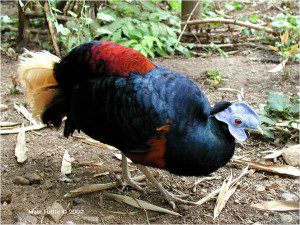

During an investigation of endogenous retrovirus diversity in Malagasy mammals, the authors found sequences related to REVs in the genomes of the ring-tailed mongoose and the narrow-striped mongoose. Phylogenetic analyses revealed that REVs entered the germline of these mammals ~8 million years ago. The entire REV lineage of mammalian and avian viruses originated from a common founder that circulated among mammals from 23 to 25 million years ago.
Based on their finding that REVs originated in mammals, the authors attempted to determine when the viruses made the jump into birds. They determined the genome sequence of an REV isolated from a duck, called duck infectious anemia virus (DIAV), and constructed phylogenies with other available REV sequences. Duck infectious anemia virus, and the closely related REV spleen necrosis virus (SNV), were both isolated from ducks that were infected with Plasmodium lophurae in 1959. Apparently the P. lophurae stocks used were contaminated with these viruses.
A search for a strain of malaria that could be used to study the disease in laboratory animals lead to isolation of P. lophurae from a Borneo firebacked pheasant in the Bronx Zoo in 1937. After P. lophurae was found to infect young chickens, stocks of the parasite were obtained by serial passage in chicken, duck, and turkey chicks. In the 1940s it became clear that the stocks of P. lophurae were contaminated with a separate agent that caused anemia in birds. William Trager in 1959 identified the anemia-inducing agent in stocks of P. lophurae as spleen necrosis virus. Duck infectious anemia virus was isolated in 1972 from P. lophurae stocks. Both SNV and DIAV were considered to be natural viruses of ducks; however it is now clear that both viruses are derived from a single introduction of REV from mammals into birds. Where this occurred is not known, but one hypothesis is that the Borneo firebacked pheasant in the Bronx Zoo, from which P. lophurae was isolated, had acquired the virus from a mammalian species at the zoo.
Stocks of P. lophurae were exhausted in the 1980s and the parasite has never been re-isolated. Since that time, no additional viruses related to SNV and DIAV have been identified, which is consistent with the idea that contaminated stocks of P. lophurae were the origin of these viruses. In China, material contaminated with REV has lead to the circulation of infectious retroviruses in birds.
In another remarkable twist, a DNA copy of the REV genome has inserted into the genome of two DNA viruses that infect birds: fowlpox virus and gallid herpesvirus 2. These viruses circulate in birds, yielding REVs that cause disease, and high antibody levels to REVs in poultry. It is not clear when REV DNA inserted into the genomes of these two DNA viruses. One possibility is that REV spread from infected laboratory birds into the environment, where the virus then recombined with the DNA viruses (during World War II stocks of P. lophurae were given to laboratories throughout the US). Another possibility is that REV insertions into the genome of fowlpox virus and gallid herpesvirus 2 occurred in vaccine stocks which were contaminated with REV.
This work supports the hypothesis that REVs were introduced into birds iatrogenically (e.g. by medical procedures). REV DNA then integrated into the genomes of an avian poxvirus and a herpesvirus, which now circulate in wild birds and poultry. Had deep sequencing been available in the 1930s, this introduction could have been prevented by analysis of the P. lophurae stocks before their introduction into birds. A similar analysis should be done on any animal-derived stocks that will be used in the laboratory.
Update: Listen to TWiV #248 for more discussion on the origins of avian REVs.

I would’ve titled this post “The High Cost of REVs.” It’s a fascinating story even without a pun based on obscure cultural references, though.
There’s a nice Primer accompanying the research article that discusses “paleovirology” and other aspects of the work:
Lucie Etienne and Michael Emerman.
“The Mongoose, the Pheasant, the Pox, and the Retrovirus”
http://www.plosbiology.org/article/info%3Adoi%2F10.1371%2Fjournal.pbio.1001641
Pingback: TWiV 248: TWiP infects TWiV
Hi there,
does the insertion of REV into fowlpox and MDV increase the “fitness” of those viruses? Does the REV DNA influence the transcription of nearby genes maybe?
Good question! I don’t believe anyone knows, but I’ll ask Rich on the next TWiV.
Thanks for your reply! Really interesting story. I assume there has to be some sort of benefit here. Otherwise the individual virus carring REV could be easily outcompeted by the ones without excess baggage.
PS: TWiV is great! It really makes my everyday way to the lab with public transport bearable! Greetings from Berlin
Timo
Pingback: TWiV 248: TWiP infects TWiV | This Week in Virology